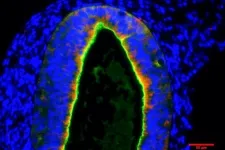(Press-News.org) Rotavirus causes gastroenteritis, a condition that includes diarrhea, deficient nutrient absorption and weight loss. Severe cases result in approximately 128,000 deaths annually in infants and children worldwide. Despite intense research on how rotavirus causes diarrhea, there is still no complete answer, but in this new study researchers at Baylor College of Medicine report a new mechanism by which rotavirus induces diarrhea, interfering with the normal absorption of nutrients in the intestine.
The study, published in Proceedings of the National Academy of Sciences, is the first to show that rotavirus-altered lipid metabolism in the intestine plays a role in the disease. Rotavirus infection leads to the degradation of DGAT1, an enzyme involved in normal lipid droplet formation in intestinal cells, which in turn reduces the production of key nutrient transporters and other proteins required for normal intestinal nutrient absorption, leading to diarrhea.
“We wanted to better understand how rotavirus exploits cellular processes to replicate,” said co-corresponding author Dr. Sue E. Crawford, assistant professor of molecular virology and microbiology at Baylor. “We used the well-established monkey kidney cell (MA104) model of rotavirus infection as well as human intestinal enteroids (HIEs) for these studies. HIEs have revolutionized the study of gastrointestinal (GI) viruses like rotavirus. These multicellular, non-transformed cell cultures retain host genetic properties, cellular organization and recapitulate the function of the human gastrointestinal epithelium. They serve as biologically relevant model systems for studying human GI infections.”
“We knew that rotavirus triggers the formation of more lipid droplets than normal in the cells it infects, as it turns the lipid droplets into virus factories. While we were studying this process, we discovered that rotavirus binds to and breaks down or degrades DGAT1, an enzyme that contributes to the formation of the lipid droplets,” Crawford said.
As the researchers looked deeper into DGAT1, they discovered that there are children who are born with mutations in DGAT1 that render the enzyme nonfunctional. “These children have severe chronic diarrhea, which sometimes is fatal,” said co-first author, Hunter Smith, graduate student in Dr. Mary Estes’ and Crawford’s lab at Baylor. “This led us to think that rotavirus-mediated degradation of DGAT1 could be a mechanism by which the virus induces diarrhea."
It was always thought that the virus caused diarrhea by infecting the intestinal cells that take up nutrients, killing them and consequently disrupting the nutrient absorption mechanisms of the intestine. “But we found a new mechanism by which rotavirus induces diarrhea. Like the children who have a genetic DGAT1 deficiency that causes diarrhea, when rotavirus degrades DGAT1 the result is reduced production of the enzymes that are involved in degrading the food we eat and disruption of the mechanisms that transport nutrients into cells, which leads to diarrhea,” Smith said.
“It was very unexpected that rotavirus has a protein that interacts with and degrades DGAT1 and that eliminating DGAT1 would lead to all these downstream effects that would cause diarrhea,” Crawford said.
Mutations on DGAT1 in children and the link to diarrhea have been known in the last 10 years. “Before that nobody would have said that there was any association between problems with this enzyme and diarrhea,” said Estes, Distinguished Service Professor of Molecular Virology and Microbiology and Cullen Foundation Endowed Chair at Baylor. She also is a member of Baylor’s Dan L Duncan Comprehensive Cancer Center and co-corresponding author of this work with Crawford. “It was very surprising that a rotavirus protein that until now was only known to be important for the virus to replicate, also plays a role in causing diarrhea, a major component of the disease. The fact that it’s not a capsid protein or part of the structure that envelops the genetic material of the virus, as we usually would think, tells us that we should not assume that nonstructural proteins do not play roles in causing disease.”
Co-first author Zheng Liu, Jeanette M. Criglar, Antonio J. Valentin, Umesh Karandikar and Xi-Lei Zeng also contributed to this work. The authors are affiliated with Baylor College of Medicine or Rice University.
This work was supported by National Institutes of Health grants (R01 AI080656, U19 AI116497 and 1S10OD028480), funding from P30 Cancer Center Support Grant (NCI-CA125123), P30 Digestive Disease Center (NIDDK-56338-13/15), CPRIT (RP150578) and the John S. Dunn Gulf Coast Consortium for Chemical Genomics.
Rotavirus causes gastroenteritis, a condition that includes diarrhea, deficient nutrient absorption and weight loss. Severe cases result in approximately 128,000 deaths annually in infants and children worldwide. Despite intense research on how rotavirus causes diarrhea, there is still no complete answer, but in this new study researchers at Baylor College of Medicine report a new mechanism by which rotavirus induces diarrhea, interfering with the normal absorption of nutrients in the intestine.
The study, published in Proceedings of the National Academy of Sciences, is the first to show that rotavirus-altered lipid metabolism in the intestine plays a role in the disease. Rotavirus infection leads to the degradation of DGAT1, an enzyme involved in normal lipid droplet formation in intestinal cells, which in turn reduces the production of key nutrient transporters and other proteins required for normal intestinal nutrient absorption, leading to diarrhea.
“We wanted to better understand how rotavirus exploits cellular processes to replicate,” said co-corresponding author Dr. Sue E. Crawford, assistant professor of molecular virology and microbiology at Baylor. “We used the well-established monkey kidney cell (MA104) model of rotavirus infection as well as human intestinal enteroids (HIEs) for these studies. HIEs have revolutionized the study of gastrointestinal (GI) viruses like rotavirus. These multicellular, non-transformed cell cultures retain host genetic properties, cellular organization and recapitulate the function of the human gastrointestinal epithelium. They serve as biologically relevant model systems for studying human GI infections.”
“We knew that rotavirus triggers the formation of more lipid droplets than normal in the cells it infects, as it turns the lipid droplets into virus factories. While we were studying this process, we discovered that rotavirus binds to and breaks down or degrades DGAT1, an enzyme that contributes to the formation of the lipid droplets,” Crawford said.
As the researchers looked deeper into DGAT1, they discovered that there are children who are born with mutations in DGAT1 that render the enzyme nonfunctional. “These children have severe chronic diarrhea, which sometimes is fatal,” said co-first author, Hunter Smith, graduate student in Dr. Mary Estes’ and Crawford’s lab at Baylor. “This led us to think that rotavirus-mediated degradation of DGAT1 could be a mechanism by which the virus induces diarrhea."
It was always thought that the virus caused diarrhea by infecting the intestinal cells that take up nutrients, killing them and consequently disrupting the nutrient absorption mechanisms of the intestine. “But we found a new mechanism by which rotavirus induces diarrhea. Like the children who have a genetic DGAT1 deficiency that causes diarrhea, when rotavirus degrades DGAT1 the result is reduced production of the enzymes that are involved in degrading the food we eat and disruption of the mechanisms that transport nutrients into cells, which leads to diarrhea,” Smith said.
“It was very unexpected that rotavirus has a protein that interacts with and degrades DGAT1 and that eliminating DGAT1 would lead to all these downstream effects that would cause diarrhea,” Crawford said.
Mutations on DGAT1 in children and the link to diarrhea have been known in the last 10 years. “Before that nobody would have said that there was any association between problems with this enzyme and diarrhea,” said Estes, Distinguished Service Professor of Molecular Virology and Microbiology and Cullen Foundation Endowed Chair at Baylor. She also is a member of Baylor’s Dan L Duncan Comprehensive Cancer Center and co-corresponding author of this work with Crawford. “It was very surprising that a rotavirus protein that until now was only known to be important for the virus to replicate, also plays a role in causing diarrhea, a major component of the disease. The fact that it’s not a capsid protein or part of the structure that envelops the genetic material of the virus, as we usually would think, tells us that we should not assume that nonstructural proteins do not play roles in causing disease.”
Co-first author Zheng Liu, Jeanette M. Criglar, Antonio J. Valentin, Umesh Karandikar and Xi-Lei Zeng also contributed to this work. The authors are affiliated with Baylor College of Medicine or Rice University.
This work was supported by National Institutes of Health grants (R01 AI080656, U19 AI116497 and 1S10OD028480), funding from P30 Cancer Center Support Grant (NCI-CA125123), P30 Digestive Disease Center (NIDDK-56338-13/15), CPRIT (RP150578) and the John S. Dunn Gulf Coast Consortium for Chemical Genomics.
###
END
A new mechanism by which rotavirus makes you sick
2023-12-11
ELSE PRESS RELEASES FROM THIS DATE:
Portable, non-invasive, mind-reading AI turns thoughts into text
2023-12-11
In a world-first, researchers from the GrapheneX-UTS Human-centric Artificial Intelligence Centre at the University of Technology Sydney (UTS) have developed a portable, non-invasive system that can decode silent thoughts and turn them into text.
The technology could aid communication for people who are unable to speak due to illness or injury, including stroke or paralysis. It could also enable seamless communication between humans and machines, such as the operation of a bionic arm or robot.
The ...
Tirzepatide enhances weight loss with sustained treatment but discontinuation leads to weight regain
2023-12-11
Tirzepatide Enhances Weight Loss with Sustained Treatment but Discontinuation Leads to Weight Regain
The current class of anti-obesity drugs is proving remarkably effective at removing excess pounds. However, a phase 3 randomized clinical trial led by researchers at Weill Cornell Medicine and NewYork-Presbyterian found that people who stopped taking the medication regained much of that weight within a year. At the same time, the study shows that remaining on the drug not only promotes additional weight loss but preserves improvements in metabolic and cardiovascular health.
The results from the SURMOUNT-4 study, which appeared Dec. ...
Scholars named for research leadership program to increase diversity in clinical trials
2023-12-11
DALLAS, Dec. 11, 2023 — The American Heart Association — the world’s leading voluntary organization dedicated to a world of longer, healthier lives for all — continues its commitment to address the lack of diversity, equity and inclusion in clinical trials for medical research with the selection of two early-career scientists for the inaugural Robert A. Winn Clinical Investigator Leadership Award in Cardiovascular Research (Winn CILA-CV). The award is sponsored by the Bristol Myers ...
Venetoclax with standard chemo-immunotherapy induced a high response rate as first-line treatment for mantle cell lymphoma and was generally well tolerated, a PrECOG early-phase trial shows
2023-12-11
The phase 2 trial PrE0405 met its primary endpoint, achieving a complete response (CR) rate of 85% in 33 patients over the age of 60 with mantle cell lymphoma (MCL) who received bendamustine and rituximab, a standard chemo-immunotherapy treatment, along with venetoclax, which is investigational in this setting. The combination was generally well-tolerated, a notable finding according to Craig A. Portell, MD, who presented the data for PrECOG, LLC, at the 65th American Society of Hematology (ASH) Meeting and Exposition in San Diego, California, ...
Schedule of sessions and press registration information now available for the ILSI 2024 Annual Meeting and Science Symposium
2023-12-11
FOR IMMEDIATE RELEASE
December 11, 2023
ILSI Global press contact:
Katherine Broendel
+1 (202) 659-0074 Ext. 175
kbroendel@ilsi.org
WASHINGTON—The International Life Sciences Institute (ILSI) has announced that its Annual Meeting, Technologies and Climate Change: Shaking up 21st Century Food Systems – Promises and Pitfalls, will take place in Clearwater, Florida, 21-24 January 2024. ILSI's Annual Meeting will feature scientific presentations, professional development and networking opportunities for researchers, academics, industry leaders, nongovernmental organizations, as well as public sector and ...
Madden studying merchants, maps & manuscripts of late medieval world
2023-12-11
Amanda Madden, Assistant Professor, History and Art History; Director, Geospatial History, received funding for the project: "La sfera (The Globe): A Late Medieval World of Merchants, Maps, & Manuscripts."
In collaboration with the project team, Co-PI Madden, Senior Developer Jason Heppler, and the Roy Rosenzweig Center for History and New Media (RRCHNM) propose to design and develop a digital edition of the text, including the user interface and data pipeline.
The NEH grant will fund the development of a dynamic, interactive ...
New project will take a step towards answering whether gravity is quantum
2023-12-11
Scientists are developing an experiment to test whether gravity is quantum
In quantum mechanics, which describes the behaviour of atoms and molecules –objects behave differently to everything we know: they can be in a quantum superposition of being in two places at the same time
Now, scientists are investigating a way to determine whether gravity operates in this way, by levitating micro diamonds in a vacuum
If gravity is quantum, it will ‘entangle’ the diamonds – an intriguing phenomenon which strongly links two objects in ways impossible in everyday life
This research will help ...
Stem cell study reveals how infantile cystinosis causes kidney failure – and how to cure it
2023-12-11
BUFFALO, N.Y. – University at Buffalo research has identified how a misstep in the genesis of a key component of the kidney causes infantile cystinosis, a rare disease that significantly shortens the lifespan of patients. Published Nov. 30 in the International Journal of Molecular Sciences, the work reveals that the mechanisms that cause the disease could be addressed and potentially cured through the genome-editing technique CRISPR. That could make kidney transplants, the most effective treatment currently available for these patients, unnecessary.
Infantile ...
Raz developing advanced model-based tools for portfolio management
2023-12-11
Raz Developing Advanced Model-Based Tools For Portfolio Management
Ali Raz, Professor, Systems Engineering and Operations Research (SEOR), received funding for the project: "Advanced Model-Based Tools for Portfolio Management and Analytic: System Architecture and Multi-Attribute Decision Making for Integrating Autonomy Phase 2 (AIRC RT-1081.07.5)."
Raz is supporting Purdue University and Georgia Tech Research Institute (GTRI) in the enhancement of the IAPR System-of-systems (SoS) tool suite.
Raz received $20,500 from Stevens Institute of Technology on a subaward from the U.S. Department of Defense for ...
SETI Institute unveils two prestigious postdoctoral fellowships: the Baruch S. Blumberg Fellowship and the William J. Welch Fellowship
2023-12-11
December 11, 2023, Mountain View, CA -- The SETI Institute announced today the establishment of a new postdoctoral research fellowship program funded by its transformative bequest from Qualcomm Co-founder, Franklin Antonio. The first two fellowships are being announced in conjunction with the American Geophysical Union Conference (AGU) being held this week in San Francisco. The Baruch S. Blumberg Postdoctoral Fellowship for Astrobiology and the William J. Welch Postdoctoral Fellowship for SETI and Technosignatures ...




